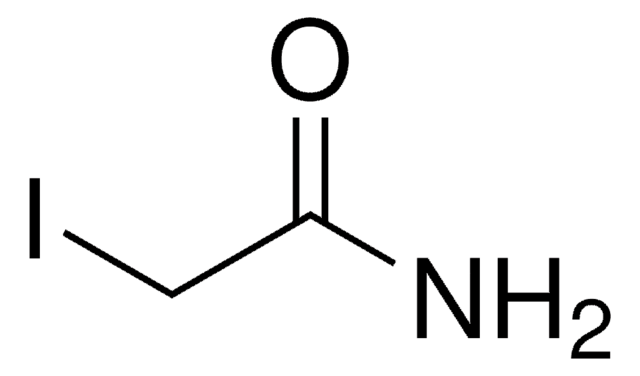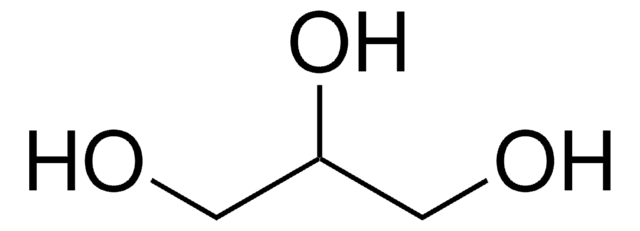D9779
DL-Dithiothreitol
≥98% (HPLC), ≥99% (titration)
Synonym(s):
(±)-Dithiothreitol, rac-Dithiothreitol, Dithiothreitol, threo-1,4-Dimercapto-2,3-butanediol, Cleland’s reagent, DTT
Select a Size
Select a Size
About This Item
Recommended Products
grade
Molecular Biology
Quality Level
Assay
≥98% (HPLC)
≥99% (titration)
form
powder
reaction suitability
reagent type: reductant
mp
41-44 °C (lit.)
solubility
H2O: 50 mg/mL
cation traces
heavy metals (as Pb): ≤5 ppm
suitability
suitable for molecular biology
foreign activity
DNase, RNase, protease, none detected
Looking for similar products? Visit Product Comparison Guide
1 of 4
This Item | G9012 | 49767 | G6279 |
|---|---|---|---|
| application(s) life science and biopharma | application(s) lipidomics | application(s) - | application(s) - |
| technique(s) MALDI-MS: suitable, cryopreservation: suitable | technique(s) immunofluorescence: suitable | technique(s) - | technique(s) - |
| grade for molecular biology, reagent | grade - | grade for molecular biology | grade - |
| Quality Level 200 | Quality Level 200 | Quality Level 200 | Quality Level 200 |
| solubility water: 1 mL/mL, clear, colorless | solubility water: 1 mL/mL, clear, colorless to faintly yellow | solubility H2O: 5 M at 20 °C, clear, colorless | solubility - |
General description
Application
Biochem/physiol Actions
Features and Benefits
- Suitable for molecular biology
- RNase, DNase, Exonuclease, and Protease-free
- High purity (HPLC ≥98%)
- No heavy metal ≤5ppm
Other Notes
comparable product
Signal Word
Danger
Hazard Statements
Precautionary Statements
Hazard Classifications
Acute Tox. 4 Oral - Eye Dam. 1 - Skin Irrit. 2
Storage Class Code
11 - Combustible Solids
WGK
WGK 3
Flash Point(F)
Not applicable
Flash Point(C)
Not applicable
Personal Protective Equipment
Choose from one of the most recent versions:
Certificates of Analysis (COA)
Don't see the Right Version?
If you require a particular version, you can look up a specific certificate by the Lot or Batch number.
Already Own This Product?
Find documentation for the products that you have recently purchased in the Document Library.
Which document(s) contains shelf-life or expiration date information for a given product?
If available for a given product, the recommended re-test date or the expiration date can be found on the Certificate of Analysis.
How do I get lot-specific information or a Certificate of Analysis?
The lot specific COA document can be found by entering the lot number above under the "Documents" section.
What is the shelf life of Product D9779, DL-Dithiothreitol?
The recommended retest period for D9779 is 4 years. This information can be found on the Specification Sheet. The actual retest date for a given lot can be found on the Certificate of Analysis for that lot.
What is the solubility of Product D9779, DL-Dithiothreitol?
This product is soluble in water (50 mg/mL), yielding a clear, colorless solution. DTT is also soluble in ethanol, acetone, ethyl acetate, chloroform and ether. This information may be found on the product information sheet for a related DTT product (Product No. D0632).
What is the solution stability of Product D9779, DL-Dithiothreitol (DTT)?
We generally recommend preparing DTT solutions fresh daily. A table showing the half life of DTT in solution under various conditions can be found on the product information sheet for a related DTT product (Product No. D0632).
What is the meaning of Molecular Biology Grade in the description of Product D9779, DL-Dithiothreitol?
Molecular Biology grade products are tested for DNase, RNase, and protease to make certain that they contain minimal levels of these contaminants.
How do I find price and availability?
There are several ways to find pricing and availability for our products. Once you log onto our website, you will find the price and availability displayed on the product detail page. You can contact any of our Customer Sales and Service offices to receive a quote. USA customers: 1-800-325-3010 or view local office numbers.
What is the Department of Transportation shipping information for this product?
Transportation information can be found in Section 14 of the product's (M)SDS.To access the shipping information for this material, use the link on the product detail page for the product.
My question is not addressed here, how can I contact Technical Service for assistance?
Ask a Scientist here.
Protocols
Follow this DDT reduction protocol to reduce disulfide bonds in thiol-modified oligonucleotides.
Our team of scientists has experience in all areas of research including Life Science, Material Science, Chemical Synthesis, Chromatography, Analytical and many others.
Contact Technical Service



